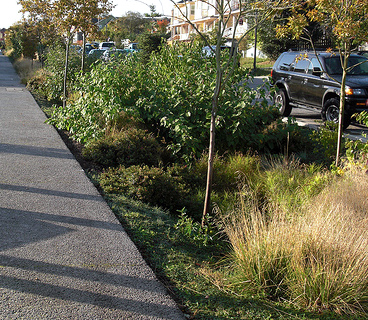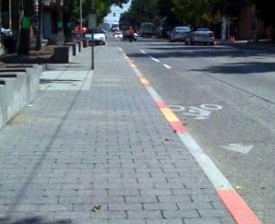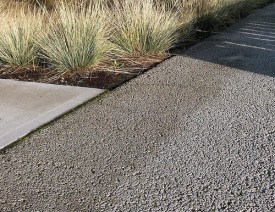Editor’s note: This post is also available as a pdf.
Permeable pavement is one of the most promising green solutions that can help reduce and clean up polluted stormwater runoff. Like conventional pavement, it can be made of asphalt or concrete that’s either poured in place or sold as pavers, and it can be used in a variety of settings, including on parking lots, low-traffic roadways, driveways, and sidewalks.
Permeable technology has been used successfully in countless Northwest paving projects, though its use has been limited by a few persistent myths.
Let’s examine some of the most common concerns.
FEAR: Permeable pavement will clog and lose its porousness.
FACT: The pavement can clog, but it’s not difficult to prevent clogging or restore its porous qualities.
Permeable pavement is pocked with pores like a rock-based rice crispy treat. Sand and dirt can clog these pores, causing water to soak in more slowly or not at all. To prevent clogging that comes from everyday use, experts recommend routine street cleaning. (Permeable roads should not be sanded in winter, although they can be treated with salts or other deicing chemicals.) If significant clogging does occur, streets and parking lots can be treated with vacuum trucks, “regenerative sweeper” trucks, or special pressure-washing devices.
In very hot weather, the sticky binder that holds asphalt pavement together can soften and “drain down,” plugging some of the pores and reducing permeability, though fibers or polymers can be added to the binder to stabilize it. It’s important to keep in mind that permeable pavement is so effective at draining water that it can suffer considerable losses in integrity and still be effective. When first installed, permeable pavement can typically absorb 100 inches of rain or more in an hour. Given that even the most intense Northwest storms seldom dump more than 1 inch of rain per hour, the pavement will continue to capture large volumes of runoff even with reduced porousness.
FEAR: Holes in permeable pavement make it weaker.
FACT: Thicker pavement and deeper base layers of rock largely mitigate weakness.
It’s true that both pervious concrete and porous asphalt are slightly weaker than conventional pavement, but thicker applications of the paving surface and the layers of rock underlying it can largely compensate for the weakness. For example, if a conventional concrete road is 5 inches thick, a pervious one needs to be 6 to 6 ½ inches thick to maintain the same strength.
Because asphalt is more pliant, street pavers can make porous asphalt stronger by installing a thicker layer of crushed rocks under the pavement to support it. That layer of rock – called the base or reservoir layer – can range from 6 to 18 inches depending on underlying soil conditions. There is a caveat: thicker permeable pavement won’t necessarily compensate for the stress created on high-volume highways.
FEAR: Permeable pavement won’t work on high-speed, high-volume roads such as highways. FACT: Permeable pavement is best suited to lower-speed, less-traveled roads, but it can safely be used on arterials.
Permeable pavement has been used successfully on highways, including a stretch of State Route 87 in Arizona. However, many experts caution against its use on high-speed, high-volume roads because small rocks in the pavement can potentially break loose, striking vehicles or windshields and causing the road to wear down.
Research in the Northwest has shown that permeable pavement installed on the shoulders of heavily traveled roadways can help reduce the total volume of stormwater and the amount of pollution in the runoff. The city of Bremerton recently installed pervious concrete shoulders
along an arterial within the South Kitsap Industrial Area, and in the 1990s the Washington Department of Transportation and King County built them along the NE Woodinville-Duvall Road north of Redmond. New research from California is bolstering the case for permeable highway shoulders.
FEAR: Permeable pavement won’t work on sloped sites.
FACT: Design features can improve the performance of permeable pavement in sloped areas.
Experts caution against using permeable pavement in areas with a slope of greater than 5 or 6 percent. (By comparison, Seattle’s steepest streets have slopes of 18 to 26 percent). Engineers worry that the water will soak through the pavement at the top of the hill, stream down the hill between the pavement and the soil, and then leak back to the surface of the pavement at the bottom. Some are also concerned that porous asphalt is not strong enough for use on hills and will break apart.
Yet permeable pavement can be installed on modest slopes. In Gresham, Oregon, for example, engineers installed porous asphalt on a 3.5 percent slope as part of the Kane Road expansion project. They built impervious clay dams and rock trenches at points underneath the arterial to prevent stormwater from running downhill and to force it to soak into the ground along the length of the street. Project engineers say the design has performed well.
FEAR: Permeable pavement will result in groundwater contamination.
FACT: Permeable pavement actually improves water quality by trapping pollutants within it and directing the water into the underlying soil where organisms remove some of the pollutants.
A study by scientists at the University of Washington found that rainwater runoff from conventional asphalt was much more contaminated than runoff that had percolated through permeable pavement. Research from the US and abroad shows that permeable pavement filters out some of the copper, lead, cadmium, and zinc in runoff by trapping it in the pavement as the water filters through it, and that microorganisms associated with the pavement and the soil beneath it can breakdown petroleum pollutants.
Cleaning the pavement with a vacuum truck sucks out heavy metals and sediment in the top millimeters of the pavement.
FEAR: Permeable pavement is prohibitively expensive.
FACT: Materials and construction for permeable pavement can cost slightly more than conventional techniques, but reducing the need for conventional stormwater systems could save much more.
Experts estimate that permeable pavement used on low-volume roadways and parking lots typically costs about 20 percent more than conventional paving. Several factors contribute to the higher costs. Thicker pavement and, in the case of asphalt, a deeper layer of crushed rock underlying the pavement is needed. There’s a price premium for the pavement because it’s a specialty product. Laying the pavement can require more hands-on construction, increasing labor costs. And construction sites need to be more deeply excavated to ensure the water will soak into the ground.
However, permeable pavement can in some situations save money in the long run. Because it can retain and treat stormwater runoff, permeable pavement can reduce or even eliminate the need for costly conventional systems of pipes, gutters, detention ponds and tanks, and treatment plants.
FEAR: Permeable pavement is more prone to rutting, breaking apart, or otherwise failing.
FACT: Permeable pavement projects are functioning well after decades of use.
If installed correctly, permeable pavement provides long-lasting surfaces. Because the first permeable pavement projects are still only a few decades old, experts don’t yet know precisely how long they will last, but we do know that roadways and parking lots built more than 20 years ago in Arizona, Pennsylvania, New Hampshire and Massachusetts are still performing well, as are projects installed nearly a decade ago in Portland.
Potholes are one of the more common pavement failures in the Northwest, caused by a pumping action when water is trapped beneath an asphalt surface that contains fine material such as sand and dirt. Permeable roads reduce the risk of potholes because the reservoir beds underlying the pavement drain the water away, and the rocks used in the pavement are filtered or washed to remove the fine material that can contribute to pothole formation.





Comments are closed.